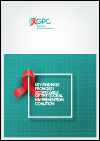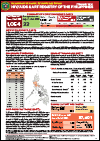What's New
Displaying results 311 - 320 of 4913
Resource | Presentations,
Browse and view tables, charts and graphs illustrating data on the Tuberculosis-HIV (TB-HIV) situation in Asia and the Pacific.
Resource | Presentations,
Get an overview of the HIV/AIDS situation for Women and Men in the Asia-Pacific region. Browse and view tables, charts and graphs illustrating data on HIV prevalence and epidemiology, risk behaviors, national response and data issues for this key population.

Resource | Publications,
The Goal of this Standard Operating Procedure (SOP) is to provide clear guidance and instruction for clinicians, health care workers and supervised CBO providers on appropriate PrEP implementation.

Resource | Publications,
The National HIV Strategic Plan 2021 – 2026 promotes a people-centred approach, grounded in principles of human rights and health equity. It will contribute to a significant decline in new HIV infections and HIV-related deaths, while also improving the health and well-being of all people living with HIV. It will guide efforts to accelerate and focus HIV prevention, empower people to know their HIV status, provide antiretroviral therapy and comprehensive long-term care to all people living with HIV, and challenge pervasive HIV-related stigma and discrimination.

Resource | Publications,
National AIDS Control Organisation (NACO), Ministry of Health and Family Welfare, Government of India periodically undertakes the HIV estimation process to provide updated information on the status of the HIV epidemic in India. The first round of HIV estimation in India was undertaken in 1998, while the last round was completed in 2019. India HIV Estimates 2020, the latest round in this series, provides the current status of the HIV epidemic in the country and its States/Union Territories (UTs) on key parameters of HIV prevalence, new infections, AIDS-related mortality and prevention of mother-to-child transmission (PMTCT) need.

Resource | Publications,
This report summarizes the fifth round of GPC reporting. It is written at a time when countries were transitioning from the 2016–2020 to the 2021–2026 Global AIDS Strategy. The report provides a forward-looking perspective on findings as of 2021, as a foundation or benchmark for the accelerated progress that is needed over the next decade. Previous GPC progress reports have detailed the 2020 Road Map—the GPC’s 10-point action plan for strengthening national HIV prevention programmes— and have reported the gains and gaps observed in implementing the Road Map using the GPC’s scorecard method. This report focuses instead on the outcomes of these efforts.

Resource | Fact Sheets,
In February 2022, there were 1,054 confirmed HIV-positive individuals reported to the HIV/AIDS & ART Registry of the Philippines (HARP) and were accounted to the total (96,266) reported cases since January 1984. Moreover, 28% (297) of individuals reported in February had advanced HIV infection at the time of testing.

Resource | Publications,
The government of Papua New Guinea has conducted three rounds of National AIDS Spending Assessment (NASA) covering the periods 2009 to 2015. The assessments have helped tracked HIV spending from international, public and private sources that contributing to the National Response to HIV in Papua New Guinea. The information proved valuable in facilitating strategic information for strategic action and decision-making, improving linkage and understanding of different actors and investors in the HIV response of the country and, at some level, in leveraging both technical and financial support for the development, implementation, management, monitoring and evaluation of PNG’s national HIV response.
Resource | Presentations,
Get an overview of the HIV/AIDS situation for Young People (15-24 years old) in the Asia-Pacific region. Browse and view tables, charts and graphs illustrating data on HIV prevalence and epidemiology, risk behaviors, vulnerability and HIV knowledge, national response for this key population.

Resource | Publications,
Over the last 20 years the Global Fund partnership has saved 44 million lives and reduced the annual death toll from HIV, tuberculosis (TB) and malaria (HTM) by 46% since its peak in countries where the Global Fund invests. We, the Global Fund partnership of implementer governments, civil society, technical partners, development partners, the private sector and people and communities affected by the three diseases, have proven that by acting together we can overcome barriers, save lives and dramatically change the course of these three terrible pandemics.





